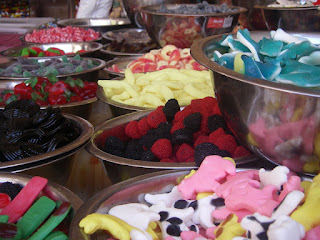One way Enrique IV really showed of his guns, was to restrict open markets and the selling of objects to certain days of the week. Only with royal authorization could merchants gather in La Plaza Mayor and sell their products. And so, certain days of the week, tents would be pitched and tables would be lined with buttery smooth sheets of silk and the air filled with the sweet sting of spices.
 As time passed, the custom continued through today, when every Thursday, in La Plaza Mayor, the people of Segovia gather in clusters of food, flowers, clothing and other goods in order to sell, barter, and share their products.
As time passed, the custom continued through today, when every Thursday, in La Plaza Mayor, the people of Segovia gather in clusters of food, flowers, clothing and other goods in order to sell, barter, and share their products.After class, our wallets stuffed with euros, we all walked to La Plaza Mayor, where voices echoed off of the buildings an into our ears before we could see where they originated from. When we arrived, the place we had passed yesterday was hardly recognizable, and as we weaved through the sea of Spaniards, blouses swinging in the wind, boxes of shiny red tomatoes, and faded cassette tape collections, it was clear that we would not get out without buying something.
Cassie's sweet tooth got the best of her, as it pulled her like a sled down a hill toward the strawberry gummies.
 Madeline, with her unassuming sense of generosity, walked casually to the flower stand and bought a bouquet of lilacs for her host mother. One vendor almost convinced Jovanna two buy a tee-shirt for a special deal, but her rational half stopped her at the last moment. And Sam and I both bought gifts for those whose names shall remain anonymous until we return home.
Madeline, with her unassuming sense of generosity, walked casually to the flower stand and bought a bouquet of lilacs for her host mother. One vendor almost convinced Jovanna two buy a tee-shirt for a special deal, but her rational half stopped her at the last moment. And Sam and I both bought gifts for those whose names shall remain anonymous until we return home.Like most things in Segovia, the rush and excitement of this weekly market stemmed from a ritual as old as your grandfather, twenty-two times great. Even though the shoppers have changed, now representing countries across the globe, the clothing styles have become more modern, and the prices have undergone a substantial amount of inflation, I believe that the atmosphere is probably the same. Whether its spices from Asia or strawberry gummies, the exhilaration of buying these special items remains unchanged.

No comments:
Post a Comment